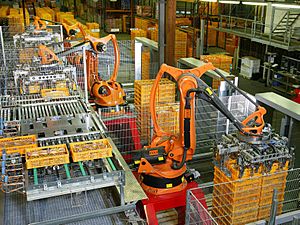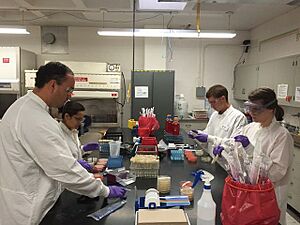Food engineering facts for kids
Food engineering is a cool field that uses science, math, and engineering ideas to make our food. It covers everything from how food is grown and processed, to how it's stored, packaged, and delivered to stores. Because food engineering uses ideas from many other types of engineering, like electrical, mechanical, and chemical engineering, it's a very diverse field.
Food engineers also study complex topics like how food changes chemically and physically. This includes things like biochemistry, microbiology, and how heat moves through food. They use all this knowledge to design and produce food that is safe, healthy, tasty, and affordable. They also work on developing new food systems, machines, and tools for the food industry.
Contents
History of Food Engineering
Even though food engineering seems new, its ideas come from very old practices. For a long time, the main goal was to keep food from spoiling. This meant making food last longer and keeping its nutrients. Old methods included drying food, canning it, and freeze-drying.
Wars and long journeys, like space missions, really pushed the need for food that lasted a long time and stayed nutritious. Ancient methods like grinding grains, storing food, and fermenting drinks were also important. While these old ways are still used, today's food engineering also focuses on making food taste good, be safe, healthy, and good for the planet.
How Food Engineering Works
Food engineers use many methods to make sure our food is safe, healthy, tasty, and sustainable. Here are some examples:
Keeping Food Cold: Refrigeration and Freezing
One main goal of cooling or freezing food is to keep it fresh and safe. Refrigeration and freezing help perishable foods last longer. They also help keep food looking good, tasting great, and holding onto its nutrients. Freezing food slows down the growth of tiny germs that could make us sick.
Removing Water: Evaporation
Evaporation is used to make liquid foods thicker or to remove water. This can change the color of food or reduce its water content. You see this process in milk, fruit juices, vegetable pastes, sauces, and sugar. Evaporation is also used to dry foods. Drying food stops molds from growing, which need moisture to survive. This method works for vegetables, fruits, meats, and fish.
Protecting Food: Packaging
Food packaging helps food last longer on the shelf. It also keeps food fresh, looking good, and protected from dirt. Cans and jars are good examples of packaging that keeps food safe.
Because making food creates a lot of waste, many companies are now using eco-friendly packaging. This helps the environment and attracts customers who care about nature. Some green packaging ideas include plastics made from corn or potatoes, compostable plastics, and recycled paper. Using eco-friendly packaging not only helps the planet but can also save companies money by using less material.
Saving Energy in Food Processing
To make food processing more sustainable, engineers try to use less energy and reuse heat that would otherwise be wasted. They are replacing old, energy-hungry processes with new technologies. This helps reduce energy use, lower production costs, and make food production more environmentally friendly.
Moving Heat in Food Processing
Heat transfer is super important for almost all processed foods. It helps keep food hygienic, nutritious, and tasty. Methods like induction, convection, and radiation are used. These methods help change how food feels and looks when it's frozen, baked, or fried. They also help with newer methods like ohmic heating. These tools allow food engineers to create new and exciting food products.
Keeping Food Safe: Food Safety Management Systems
A Food Safety Management System (FSMS) is a plan to control anything that could make food unsafe. In some countries, it's a law for food businesses to have an FSMS. These systems are often based on something called HACCP (Hazard Analysis Critical Control Point). HACCP helps find and control dangers like bad germs or chemicals at every step of making food. The ISO 22000 standard sets the rules for these food safety systems.
New Technologies in Food Engineering
New technologies are always changing and improving how food is made. Here are some exciting ones:
3D Printing Food
Three-dimensional (3D) printing uses digital files to create objects layer by layer. In the food world, 3D printing makes food by building up layers using computer control. It's still a bit slow, but it's getting faster and cheaper. Some foods that have been successfully 3D printed include chocolate, cheese, cake frosting, pizza, and even turkey. This technology could one day make food that is cheaper, uses less energy, is nutritious, safe, and offers lots of variety.
Smart Sensors: Biosensors
Biosensors are tiny devices that can check food quality in labs and during processing. They help farmers and food companies keep up with the world's growing demand for food while keeping quality high. Since many people get sick from food-borne germs, biosensors are important for making sure food is safe. They can track food quality from the factory to the store. Biosensors can also help find genetically modified organisms (GMOs) in food. As technology improves, biosensors are becoming even better and more useful.
Microwaving Milk for Pasteurization
Milk tastes best when it's stored properly. But sometimes, milk can get an "oxidized" flavor, which makes it taste bad and can affect its safety. Pasteurization is a process that heats milk to kill harmful bacteria and make it last longer. Scientists have found that microwaving milk for pasteurization can prevent this oxidized flavor better than traditional methods, leading to better quality milk.
Learning About Food Engineering
Food engineering became a formal school subject in the 1950s. Today, universities around the world offer degrees in food engineering. Often, it's taught as part of bigger programs like food science, biotechnology, or chemical engineering. Students learn about math, chemistry, physics, microbiology, and nutrition.
Food engineering is still growing, and what students learn keeps changing. This is because of new challenges in the food industry, like feeding more people, making food safe, and dealing with climate change. To solve these problems, schools are adding new ways of learning, like innovation labs and projects with food companies. There are even competitions for young food engineers!
With more and more people wanting safe, healthy, and sustainable food, there are many jobs for food engineers. They can work in food companies, universities, government, research centers, and even start their own businesses. They might be food engineers, food microbiologists, or work in food safety and quality.
Big Challenges for Food Engineers
Making Food Sustainable
Making food can sometimes harm the environment by creating a lot of waste and polluting water and air. Food engineers need to find ways to reduce this impact. Scientists are always trying to create better processes that cause less pollution. Food engineers must rethink how food is made to use less water and energy, and create less waste.
Feeding a Growing Population
The world's population is growing fast, and by 2050, there could be 9-10 billion people. This means we need to produce more food, but also deal with problems like not enough land and water. Food engineers must find sustainable ways to grow and produce enough food for everyone, especially those who don't have enough to eat. They face the challenge of making more food without destroying forests or using up all our resources.
Improving Human Health
People today want food that is healthy and nutritious. Food engineers must work with doctors, chemists, and other experts to create foods that are good for us. They need to develop new technologies and methods to produce more healthy foods that have a positive impact on human health.
See also
 In Spanish: Ingeniería en alimentos para niños
In Spanish: Ingeniería en alimentos para niños
- Pharmaceuticals
- Food science
- Food technology
- Aseptic processing
- Dietary supplement
- Food and biological process engineering
- Food fortification
- Food preservation
- Food rheology
- Food supplements
- Future food technology
- Nutraceutical
- Nutrification
- Food and Bioprocess Technology
- Food safety
- Food chemistry
- Food physical chemistry
- Pasteurization
- Food dehydration
- Biosensors
- Biochemistry
- Microbiology
- Food quality
- Stabiliser





